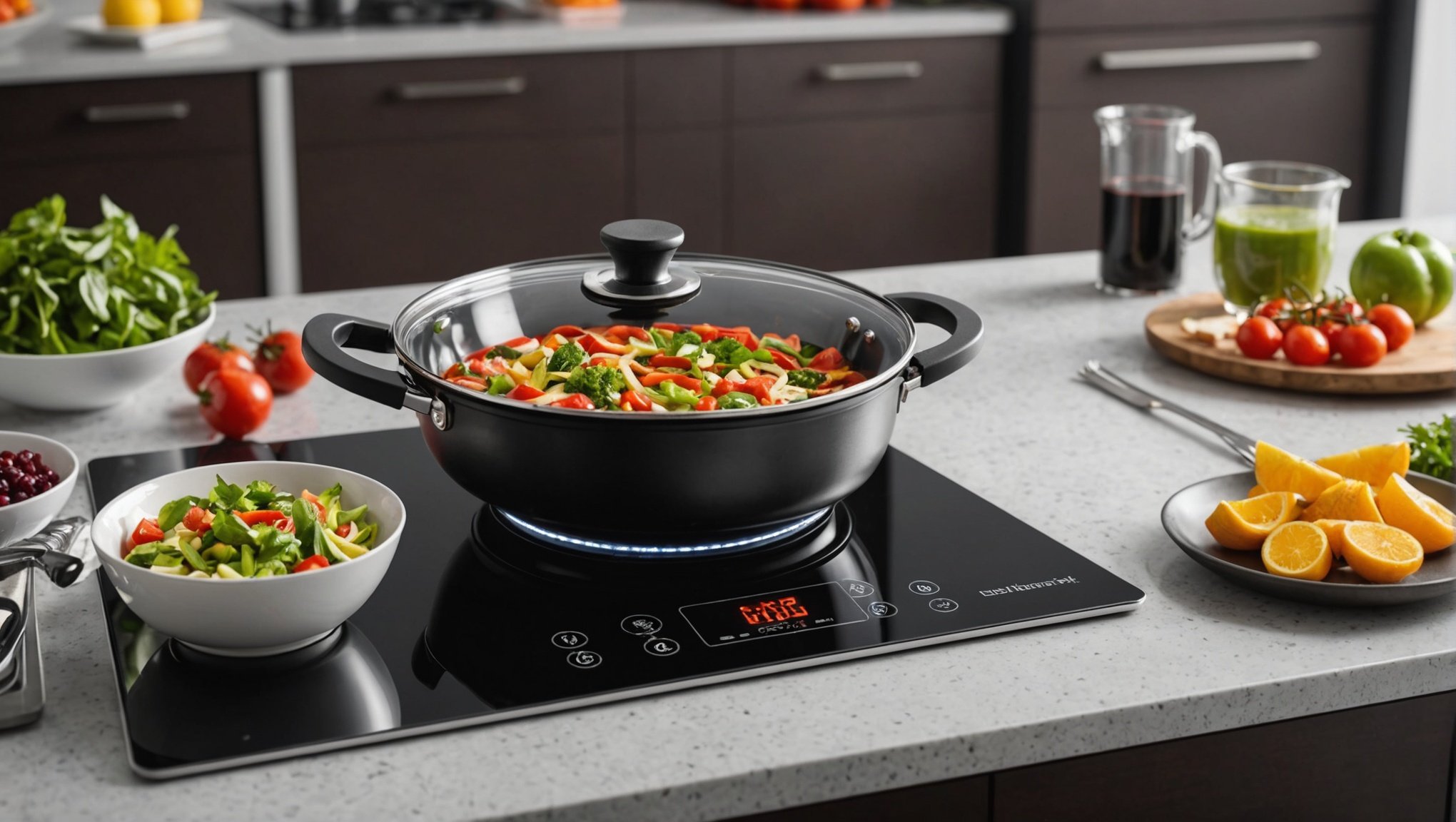Are you ready to revolutionize your cooking experience? Switching to an induction cooktop not only enhances your culinary efficiency but also leads to significant energy savings. Enjoy precise temperature control for healthier meal preparation while reducing your energy bills. This modern cooking method also boasts safety features that traditional appliances lack, making your kitchen safer for everyone. Discover how making this simple transition can transform your cooking routine and contribute to a more sustainable lifestyle.
Energy Efficiency of Induction Cooktops
Induction cooktops are renowned for their energy efficiency, offering a modern solution to traditional cooking methods. Unlike conventional electric or gas cooktops, induction models use electromagnetic fields to directly heat pots and pans. This direct heating method results in significantly less energy loss, as the surrounding air and cooktop surface remain relatively cool.
Also to discover : Unlocking Sustainable Food Waste Solutions: The Advantages of Using a Kitchen Compost Bin
Energy Savings: A Comparative Analysis
When comparing energy consumption, induction cooktops stand out. Traditional cooktops often waste energy by heating the air around them, while induction models focus energy precisely where it’s needed. This precision not only reduces cooking time but also minimises energy use. For example, boiling water on an induction cooktop can be up to 50% faster than on a gas stove, translating to substantial energy savings over time.
Long-term Benefits for Households
The long-term savings potential for households investing in induction cooktops is noteworthy. While the initial cost may be higher, the reduction in energy bills and cooking times can lead to significant savings in the long run. Additionally, the enhanced control over cooking temperatures can improve meal quality, making induction cooktops a smart and sustainable choice for modern kitchens.
Also to discover : Unlocking Sustainable Food Waste Solutions: The Advantages of Using a Kitchen Compost Bin
Health Benefits of Induction Cooking
Induction cooktops offer numerous health benefits that contribute to safer and cleaner cooking environments. One of the most significant advantages is the reduced risk of burns and fire hazards. Unlike traditional gas or electric cooktops, induction surfaces remain cool to the touch, minimising the danger of accidental burns. This makes them particularly suitable for households with children or elderly individuals.
Moreover, induction cooking is associated with lower emissions of harmful substances. Gas stoves can release pollutants like nitrogen dioxide and carbon monoxide, which may negatively impact indoor air quality. In contrast, induction cooktops do not emit these gases, leading to a healthier kitchen environment. This reduction in pollutants can significantly benefit respiratory health, especially for individuals with asthma or allergies.
Improved indoor air quality is another critical factor. Traditional cooking methods can increase indoor air pollution, affecting overall health. Induction cooktops mitigate this issue by eliminating combustion-related emissions. Consequently, they contribute to a cleaner, safer home environment.
By choosing induction cooking, individuals can enjoy a modern cooking experience while prioritising safe cooking practices and promoting better health outcomes.
Cooking Performance and Experience
Induction cooking is celebrated for its superior cooking performance and enhanced user experience. A standout feature is its precision temperature control, allowing cooks to adjust heat levels with remarkable accuracy. This responsiveness ensures that dishes are cooked to perfection, whether simmering delicate sauces or searing steaks. The rapid heat adjustments available with induction cooktops provide an unparalleled level of control, which is especially beneficial for recipes requiring precise temperature shifts.
The versatility of induction cooktops extends to a wide range of cooking techniques and styles. From traditional methods like boiling and frying to more sophisticated culinary practices such as sous-vide and poaching, induction cooking accommodates diverse preferences. This adaptability makes induction cooktops a favourite among both amateur cooks and seasoned chefs, offering a flexible cooking platform that can handle any culinary challenge.
User testimonials frequently highlight the satisfaction derived from using induction cooktops. Many users report a significant improvement in their cooking experiences, praising the efficiency and ease of use. The seamless integration of technology and cooking performance not only enhances the overall user experience but also encourages a more adventurous approach to home cooking.
Cost Comparisons: Induction vs. Traditional Cooking
When evaluating the cost comparison between induction and traditional cooking methods, several factors come into play. The initial investment for induction cooktops is typically higher than for gas or electric models. This is due to the advanced technology and materials used in their construction. Installation costs can also vary, especially if electrical upgrades are necessary to accommodate the induction cooktop.
Long-term Operational Costs
Despite the higher upfront costs, induction cooktops offer significant savings in long-term operational costs. Their energy efficiency translates to lower electricity bills, as they use energy more effectively than traditional gas stoves. Over time, these energy savings can offset the initial purchase and installation expenses.
Value Assessment
When assessing the value of induction cooktops, it’s essential to consider their lifespan and performance. Induction cooktops are known for their durability and precision, which can enhance cooking experiences and reduce maintenance costs. This makes them a worthwhile investment for households seeking efficient and reliable cooking solutions. Ultimately, the decision between induction and traditional cooking methods should factor in both the initial investment and the potential for long-term savings.
Transitioning to Induction Cooking
Switching to induction cooking requires some adjustments, particularly in terms of necessary cookware. Induction cooktops work best with ferrous metal pots and pans, such as those made from cast iron or stainless steel. To check compatibility, see if a magnet sticks to the base of your cookware. If it does, you’re good to go!
Practical Tips for a Smooth Transition
To ensure a seamless transition, gradually integrate induction-compatible cookware into your kitchen. Start by replacing frequently used items, such as frying pans and saucepans. This approach helps manage costs and allows you to get accustomed to the new cooking style. Consider investing in a versatile induction-compatible cookware set for convenience.
Common Challenges and Solutions
One common challenge is adjusting to the rapid heating of induction cooktops. To address this, begin cooking at lower temperatures than you would with traditional methods. This helps prevent overcooking or burning until you become familiar with the cooktop’s responsiveness. Additionally, some users may experience issues with noise, such as buzzing or humming. This is typically due to the cookware’s construction and doesn’t affect performance. Opt for heavy, flat-bottomed pots and pans to minimise noise. By following these cooking tips, you can enjoy a smooth and efficient transition to induction cooking.
Environmental Impact of Induction Cooktops
Induction cooktops play a pivotal role in promoting sustainable cooking, significantly reducing the environmental impact compared to traditional methods. One of the most notable benefits is the reduction in carbon footprint. Unlike gas stoves, which emit carbon dioxide (CO2) during combustion, induction cooktops operate without producing direct emissions. This makes them an eco-friendly alternative for environmentally conscious households.
Comparing CO2 Emissions
When examining CO2 emissions, induction cooking emerges as a clear winner. Gas stoves release pollutants, contributing to indoor and outdoor air pollution. In contrast, induction technology relies on electricity, which can be sourced from renewable energy, further minimising its environmental impact. This shift not only reduces greenhouse gas emissions but also supports the transition to energy-efficient homes.
Energy Efficiency and Sustainability
The potential for energy-efficient homes is enhanced with induction technology. By using electromagnetic fields to heat cookware directly, induction cooktops minimise wasted energy, aligning with sustainable living goals. This efficiency not only conserves resources but also lowers household energy consumption, contributing to a greener planet. Embracing induction cooking is thus a practical step towards a more sustainable future.
User Testimonials and Case Studies
User testimonials and case studies provide invaluable insights into the real-life experiences of those who have transitioned to induction cooking. Many users report significant energy savings, with some noting a noticeable decrease in their monthly electricity bills. This aligns with the energy-efficient nature of induction cooktops, which focus heat directly on the cookware, minimising waste.
In terms of health benefits, users frequently mention the improved indoor air quality as a major advantage. Unlike gas stoves, induction cooktops do not emit harmful gases, creating a healthier cooking environment. This has been particularly beneficial for households with individuals suffering from respiratory issues.
Recommendations from users often highlight the importance of selecting the right cookware to maximise the benefits of induction cooking. Brands like Le Creuset and Tefal are commonly recommended for their compatibility and performance. Additionally, users suggest starting with a few essential induction-compatible pots and pans to ease the transition.
Real-life experiences underscore the practicality and advantages of induction cooking, offering a compelling case for those considering making the switch. By sharing their experiences, users help others make informed decisions about adopting this modern cooking technology.
Visuals and Infographics
Visual aids, such as infographics, play a crucial role in conveying the benefits of induction cooking. They provide a clear and concise way to understand complex information, making it easier to compare different cooking methods. Infographics can effectively highlight the energy savings and health impacts associated with induction cooktops.
Understanding Induction Benefits Through Visual Data
Infographics offer a compelling visual representation of how energy-efficient induction cooktops are compared to traditional gas and electric models. By illustrating the percentage of energy saved, these visual tools help readers grasp the potential cost reductions and environmental benefits of switching to induction cooking.
Moreover, visual data can demonstrate the health advantages of induction cooktops. By comparing emissions from gas stoves to the clean operation of induction models, infographics can underscore the positive impact on indoor air quality. This is particularly relevant for households with respiratory concerns.
Infographics also provide side-by-side cooking comparisons, showcasing the speed and precision of induction cooking. By visually representing these attributes, readers can quickly appreciate the enhanced cooking performance and user experience that induction technology offers.






